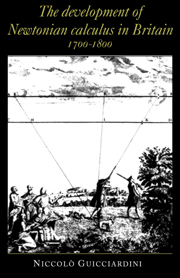Book contents
- Frontmatter
- Contents
- Introduction
- OVERTURE: NEWTON'S PUBLISHED WORK ON THE CALCULUS OF FLUXIONS
- PART I THE EARLY PERIOD
- PART II THE MIDDLE PERIOD
- PART III THE REFORM
- 7 SCOTLAND (1785–1809)
- 8 THE MILITARY SCHOOLS (1773–1819)
- 9 CAMBRIDGE AND DUBLIN (1790–1820)
- CONCLUSION
- APPENDIX A TABLES OF CONTENTS OF FLUXIONARY TEXTBOOKS
- APPENDIX B PRICE LIST OF MATHEMATICAL BOOKS PRINTED FOR JOHN NOURSE
- APPENDIX C CHAIRS IN THE UNIVERSITIES
- APPENDIX D MILITARY ACADEMIES
- APPENDIX E SUBJECT INDEX OF PRIMARY LITERATURE
- APPENDIX F MANUSCRIPT SOURCES
- Notes
- Bibliography
- Index
8 - THE MILITARY SCHOOLS (1773–1819)
from PART III - THE REFORM
Published online by Cambridge University Press: 14 September 2009
- Frontmatter
- Contents
- Introduction
- OVERTURE: NEWTON'S PUBLISHED WORK ON THE CALCULUS OF FLUXIONS
- PART I THE EARLY PERIOD
- PART II THE MIDDLE PERIOD
- PART III THE REFORM
- 7 SCOTLAND (1785–1809)
- 8 THE MILITARY SCHOOLS (1773–1819)
- 9 CAMBRIDGE AND DUBLIN (1790–1820)
- CONCLUSION
- APPENDIX A TABLES OF CONTENTS OF FLUXIONARY TEXTBOOKS
- APPENDIX B PRICE LIST OF MATHEMATICAL BOOKS PRINTED FOR JOHN NOURSE
- APPENDIX C CHAIRS IN THE UNIVERSITIES
- APPENDIX D MILITARY ACADEMIES
- APPENDIX E SUBJECT INDEX OF PRIMARY LITERATURE
- APPENDIX F MANUSCRIPT SOURCES
- Notes
- Bibliography
- Index
Summary
the military schools played an interesting role in the reform of the British calculus. At Woolwich we find a group of engineers including Hutton, Barlow, Gregory and Bonnycastle. They had at their disposal the dockyard, the arsenal and nautical instruments, and so were in a position to investigate the strength of materials, magnetism and ballistics. Their knowledge of similar work in France was extensive, while their own contributions to engineering were known on the continent. They did not excel as mathematicians, and, with the exception of Bonnycastle, they did not break with the fluxional tradition. As teachers they could not introduce any sophisticated innovations into the curriculum for the ‘raw and inexperienced’ cadets. However, with their textbooks and essays they greatly contributed to improving the knowledge of continental science in Britain. At Sandhurst more basic research on integration was carried out by the two Scots, Ivory and Wallace, assisted by Leybourn and several other colleagues. They contributed to a Mathematical Repository, where differential notation, partial derivatives and difference equations appeared as early as 1806. Their work marked a significant step towards the continental calculus. Certainly it was not possible for them to introduce their students to more than algebra and trigonometry. The masters at the military schools also participated actively in the astonishing number of scientific journals and encyclopaedias published during the first decades of the nineteenth century. Their contribution to the development of British science has been unjustly neglected.
- Type
- Chapter
- Information
- The Development of Newtonian Calculus in Britain, 1700–1800 , pp. 108 - 123Publisher: Cambridge University PressPrint publication year: 1989



